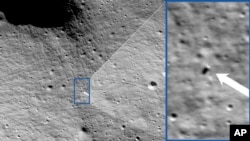Odysseus, the first U.S. spacecraft to land on the moon since 1972, has about 10 to 20 hours of battery life left, according to flight controllers who are still in contact with the robotic lander.
Texas-based Intuitive Machines said Tuesday that its flight controllers were in communication with the Odysseus lunar lander and that the spacecraft had relayed payload science data and images in the morning. NASA paid Intuitive $118 million to build and fly the spacecraft to the moon, carrying scientific instruments for NASA and several commercial customers.
The plane touched down on Friday, but its operational schedule of seven to 10 days was expected to be shortened after landing sideways. Intuitive said the company is still working on finalizing the lander’s battery life.
The company’s shares fell 16% on Tuesday, recouping some of those losses after Intuitive said it remained in contact with the lander. Still, the stock erased most of its gains from the end of last week.
It remains to be seen how much research data and images from various payloads will not be collected due to Odysseus’ shortened lunar lifetime.
The Nova-C class lander was launched from NASA’s Kennedy Space Center in Florida on February 15 on a Falcon 9 rocket supplied by Elon Musk’s SpaceX. Six days later, the hexapod reached lunar orbit.
Despite a navigation failure at the 11th hour, Odysseus completed its final lunar descent and landed the next day (February 22) near its intended destination in the lunar south pole region.
An unexpectedly weak initial radio signal from the spacecraft confirmed it arrived intact but suggested something had gone wrong.
Intuitive executives said on February 23 that engineers had determined that Odysseus caught the foot of one of its landing legs on the rugged lunar surface as it approached landing and tipped over before coming to rest horizontally. Apparently it was supported on a rock.
Intuition admitted at the time that the lander’s sideways attitude caused its two communications antennas to point downward, making them unusable, while limiting the solar panels’ exposure to sunlight and thereby limiting their ability to charge the batteries.
Only one of NASA’s six experiments appears to have been physically affected and all commercial payload needs can still be met, company officials said.
The company said Monday that based on calculations of the positions of the Earth and moon, flight engineers expected Odysseus to go dark on Tuesday morning once sunlight could no longer reach its solar panels.
Although the landing was less than ideal, Odysseus became the first American spacecraft to land on the moon since NASA’s last manned Apollo lunar mission in 1972.
It was also the first landing on the moon by a commercially built and operated space vehicle and the first for NASA’s Artemis program, which aims to return astronauts to Earth’s natural satellite this decade.
The unfortunate events surrounding the Odysseus mission once again illustrate the risks inherent in NASA’s strategy of relying more on small, relatively inexperienced private companies than in the Apollo era.
A month ago, another U.S. company’s Astrobotic Technology lunar lander encountered a propulsion leak on its way to the moon shortly after it was installed on a United Launch Alliance (ULA) Vulcan rocket on January 8.
Japan Aerospace Exploration Agency’s (JAXA) ultra-thin lunar lander in January experienced a similar setback to Odysseus, which also ran out of power after tipping over on the lunar surface, causing its solar panels to Wrong angle.
However, the Japan Aerospace Exploration Agency reported on Monday that its “precision” lander unexpectedly survived the cold lunar night and reestablished contact with Earth more than a month after arriving on the moon.
Follow us on Google news ,Twitter , and Join Whatsapp Group of thelocalreport.in


















